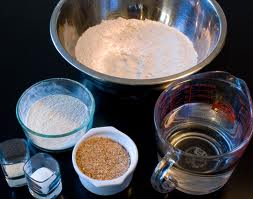Fooducate Blog - The 20 Most Common Bread Ingredients [Bread miniseries part 3/4] |
| The 20 Most Common Bread Ingredients [Bread miniseries part 3/4] Posted: 28 Jun 2012 05:52 AM PDT  photo: pastrypal.com New here? Get Fooducated with our iPhone or Android App! Or try Fooducate on the Web! Welcome to part 3 of our miniseries. In part 1, we provided ground rules for choosing healthy bread. In part 2, we explained what whole grains are. Today we'll take a look at the other ingredients in bread. To do this, we analyzed the ingredient lists of over 2,000 breads. The average list had 20-25 ingredients! That's 5 times more ingredients than you need for a basic bread (flour, water, yeast, salt). By the way, some ingredients such as dough conditioners, don’t even appear in the ingredient list because they are used in small amount. Here’s the list, we’ve marked controversial additives with asterisks ***. 1. Flour - Less than half of the breads we analyzed included whole wheat flour, the rest were refined or enriched flours. 2. Salt – required for flavor and to balance the fermentation by the yeast. See #4. 3. Water 4. Yeast- yeast is a living organism. It ferments the carbohydrates in dough and converts them to carbon dioxide bubbles, which makes the dough rise. 5. Vitamins & minerals – this is what's added to refined flour – Vitmin B1 (thiamin), Vitamin B2 (riboflavin), Vitamin B3 (niacin), folic acid, and iron. Whole grain flours do not need the addition because they contain these nutrient and more in the bran and germ. In fact, enrichment means returning that which hath been stripped away through the refinement of the wheat… 6. Soybean oil – oil or fats used in bread make the crumb (texture) more tender and rich in flavor (and calories!) They also extend shelf life to some extent, preventing the bread from going stale. Soybean is the cheapest possible oil, and thus is used most. If you prepare your own loaf – try olive oil. 7. Wheat gluten - Gluten increases the dough's ability to rise. It also increases the bread's structural stability and chewiness. Although gluten is naturally present in flour, it requires substantial kneading to be released. Adding wheat gluten is a shortcut. 8. Calcium sulfate – better known as plaster of Paris – is a clear white rock found in nature. Used in bread as a dough conditioner. Commercial bakeries employ various dough conditioners for several reasons: (1) to shorten dough rising times (2) to increase shelf life and (3) make the dough easier for their machinery to process. *** 9. Mono and di-glycerides, ethoxylated mono and di-glycerides – derived from animal or plant sources, these additives have multiple roles – they are dough conditioners (improve texture, increase volume), emulsifiers, and release agents (make it easier to get the bread out of the baking pan). *** 10. High-fructose corn syrup – many breads employ a sweetener to improve taste as well as help the dough rise. (Yeast love sugar – they ferment it to create carbon dioxide which is what makes the bread rise. HFCS is the cheapest sugar, and that is why manufacturers use it. *** 11. Calcium propionate – a preservative that inhibits mold and bacterial growth. Considered safe, but in the early 1990′s it was linked to attention deficit disorder in children. 12. Soy lecithin – a very popular additive that helps bind the various ingredients in the bread, improves shelf life and also helps. Read more on soy lecithin. 13. Sodium stearoyl lactylate – used as an emulsifier used as a dough conditioner. It maintains texture, increase the volume of the loaf, keeps fats mixed well with the dough, and serves as a humectant, to absorb more water per loaf (cheapest ingredient is water!). It is also slightly sweet. 14. Monocalcium phosphate – a leavening agent and preservative. 15. Enzymes – decrease the time it takes dough to rise. The two most popular enzymes used are Amylase and Protease. 16. Ammonium sulfate - food for yeast. Helps the dough rise faster. 17. Ascorbic acid – this is vitmin C. It's not added for your health, but rather to create a slightly acidic environment for the yeast to ferment more effectively, thus decreasing the time it takes the dough to rise . 18. Honey *** 19. Azodicarbonamide – another dough conditioner. It also bleaches the flour (makes it whiter). It's considered safe in the US at up to 45 parts per million, but is banned from use in Europe because studies showed it could cause asthma or allergic reactions. *** 20. DATEM – an acronym for Diacetyl Tartaric Acid Esters of Monoglycerides. Another dough conditioner used to improve volume and uniformity. It is considered safe by the FDA, but a study in 2002, on rats, showed "heart muscle fibrosis and adrenal overgrowth". Sources:
Get Fooducated: Follow us on twitter: twitter.com/fooducate on facebook: facebook.com/fooducate |
| You are subscribed to email updates from To stop receiving these emails, you may unsubscribe now. | Email delivery powered by Google |
| Google Inc., 20 West Kinzie, Chicago IL USA 60610 | |


No comments:
Post a Comment